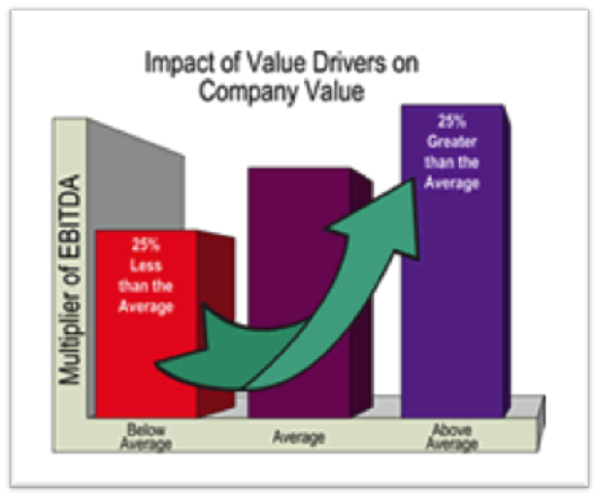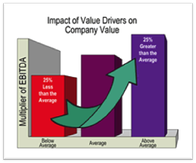CEO Blog - Advice for CEOs on growth and scaling
5 Ways to Maximize Business Value for Selling a Business

Today's blog is by guest blogger, Curt Cyliax.
How can you boost your company’s short-term earnings while maximizing long-term value? After managing the purchase and sale of a number of companies, we’ve identified five primary drivers to maximize business value.
value? After managing the purchase and sale of a number of companies, we’ve identified five primary drivers to maximize business value.
If you’re a business owner who plans on selling a business or transfering your company in the future, you’ll want to know how you can maximize the value of your business, make it more attractive to potential buyers, and get top dollar for your business.
What are buyers looking for in a business acquisition? Ultimately, they want an investment that minimizes their risk and maximizes their return. There are several key characteristics – value drivers – that can help increase the value of a business by reducing the risks of owning the business, while demonstrating an increased likelihood of future growth.
By working to improve the following value drivers now, you’ll pave the way to a premium price when you're selling a business:
1. A strong, motivated management team
Motivating and retaining top talent is crucial for the sale value of your company. Does your management team have the leadership, skills and drive to fluidly grow the company when you leave? Are the appropriate incentives and employment agreements in place to help keep management after the sale? A strong and motivated management team demonstrates to buyers that the value of the business is not completely dependent on the company’s owner.
2. Recurring revenue and multiple streams of revenue
The larger the portion of a company’s revenue that is recurring, stable and likely to continue in the future, the more desirable that company is to prospective buyers. In addition, multiple revenue streams – the number of different ways a business earns money – can help reduce the risk that any single product or service might fail. In other words, buyers are more willing to pay a premium for businesses that demonstrate predictable earnings for the future.
3. Customer diversification
If your company’s largest customer left, what would be the impact on your business? If the answer is “significant,” then potential buyers would likely perceive your business as a high-risk investment. That’s why building a diversified customer base is critical. A good rule of thumb is that a business should have no single customer that accounts for 10% or more of revenue.
4. Realistic strategic growth plan and scalability
How will your business get to the next level? Buyers are interested in the future, so having a realistic plan that demonstrates the potential for growth and profitability for your business is important. Are there new products or services in the pipeline? Is the business scalable? Can you take the business model and roll it into new markets successfully? These are just a few examples of the growth opportunities business owners can use to estimate their company’s future growth potential for buyers.
5. Financial systems and controls that can withstand due diligence
When purchasing a business, buyers will typically scrutinize the company’s performance during due diligence, reviewing the company’s past performance. So the quality of your financial information can have a huge impact on the sale of your business. Are your books and records accurate and detailed? Are your company’s financial statements reviewed or audited by outside accountants? Having reliable financial systems and controls in place to manage your business, protect your assets, and support your company’s financial claims are critical to a successful sale.
Focus on these value drivers to increase your company’s profitability, improve market value, and maximize business value throughout running your company to prepare for selling a business.
The Author:
 Curt Cyliax is Managing Partner of SEA (Strategic Exit Advisor), transaction advisors and liquidity planning professionals for lower middle market businesses. SEA creates, grow, and unlocks liquidity for middle market business owners in the mid-Atlantic region. Curt can be reached at cacyliax@se-adv.com.
Curt Cyliax is Managing Partner of SEA (Strategic Exit Advisor), transaction advisors and liquidity planning professionals for lower middle market businesses. SEA creates, grow, and unlocks liquidity for middle market business owners in the mid-Atlantic region. Curt can be reached at cacyliax@se-adv.com.
If you have questions about how to enhance the value drivers of your business, or want to develop a liquidity plan for your company, the experts at SEA can help. Contact us or give us a call at 215-489-8881 to begin planning today for a secure tomorrow.
Topics: Growing Market Share, Differentiation, Revenue Growth, Management Insights
Wed, Jun 19, 2013Related Articles

- Press Releases
- Careers
- Case Studies
- Marketing Consultant Company
- Marketing Strategy Consultants
- Marketing Plan Consultants
- B2B Marketing Consultants
- Virtual CMO
- Marketing Consultant Outsourcing
- Fractional CMO
- What is a Fractional CMO
- Healthcare Marketing Consultant
- Marketing Consultant Houston TX Texas
- Marketing Consultant Texas TX
- Marketing Consultant Bay Area
- CEO Blog
- Ebooks Plus
- Executive Marketing Consultants
- Product Marketing Consultants
- B2C Marketing Consultants
- Virtual Marketing Consultants
- Senior Marketing Consultants
- Temporary CMO
- Hire a CMO
- Fractional CMO Salary
- Fractional CMO Responsibilities
- Marketing Consultant Austin TX Texas
- Marketing Consultant Dallas TX Texas
- Marketing Consultant San Antonio
- Helping Private Equity
- Private Equity Blog
- Leadership Team
- Privacy Policy
- Business Marketing Consultants
- Strategic Marketing Consultants
- Marketing Technology Consultants
- Sales and Marketing Consultants
- CMO Job Description
- CMO Salary
- Fractional CMO Agency
- Fractional CMO Services
- CPG Marketing Consultant
- Marketing Consultant San Diego
- Partners
Houston, TX 77056
© 2023 Chief Outsiders


